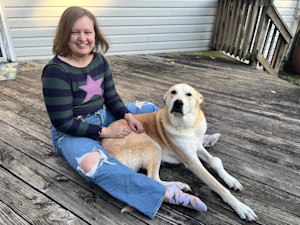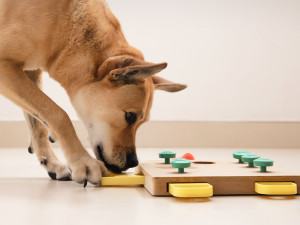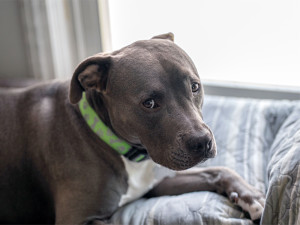What Are Dog Communication Buttons? And How to Use Them
Cognitive Science professor Dr. Federico Rossano on how Bunny, TikTok’s “talking” dog, is sparking change in how we communicate with our pets.
In This Article:
How Do Dog Communication Buttons Work? How to Train Your Dog to Use Communication Buttons What to Know Before Getting Dog Communication Buttons Can Dogs Really Communicate With Buttons? Communication Button Use Cases Frequently Asked Questions
During the pandemic, lots of people not only adopted pets, but also spent exponentially more time with the ones they already had. This resulted in stronger bonds and some pretty next-level pet-related hobbies. The most elaborate of them all? Teaching your pet how to communicate using a variety of push buttonsopens in new tab.
Bunny, a Sheepadoodle sensation on TikTokopens in new tab, is probably the most recognizable dog who pushes buttons to communicate, garnering millions of views around the world. In one video, you can see Bunny press them to express her “mad” feelings about baths. In another, she alerts her mom to an “ouch” in her ear. She even got existential by showcasing her ability to recognize herself in a mirror, dreaming of more rainopens in new tab, and questioning whether her new brother (a dog named Otter) was a human or a dog.
Can dogs actually communicate with buttons? While your dog may not become as fluent in communicating with buttons as Bunny and other social media-famous pets, you can still teach your dog to “talk” to you and express their feelings.
How much do you spend on your pet per year?
How do dog communication buttons work?
Dog buttons for communication are a form of augmentative interspecies communicationopens in new tab (AIC) device, which means that these buttons enable humans to communicate with other species. They are designed to help dogs (and cats) express their wants, needs, and feelings, and even ask questions about their environment.
These are recordable, allowing you to record words and phrases in your own voice. These phrases can include everything from simple concepts like “outside” to expressions like “love you!” Dogs learn to associate the button and the word it says with a specific outcome, allowing them to “speak” to their human parents.
How to train your dog to use communication buttons
Teaching your dog to “talk” may sound challenging, but dog communication button training is possible with patience and commitment. Start with just a few words and work on getting your dog to hit the button and understand what the words mean.
“I like to use a process called Shaping, where you pick a specific goal and reward the dog for successive approximations toward that goal,” dog trainer Elizabeth H. “Kizz” Robinsonopens in new tab says.
Use positive reinforcement
Make sure to praise your dog when they press the button, but try to avoid using treats; this can give the wrong impression. Your dog may begin to think that pressing the button means getting a treat, instead of learning that they’re communicating their needs or feelings.
Model words for your dog
When you’re starting out, you should use the buttons when appropriate to show your dog the right context and meaning for each word. For example, when your dog picks up a toy, press the “play” button. Instead of devoting a specific time each day to button training, simply use the words whenever they’re applicable.
Respond when your dog explores buttons
Your dog won’t understand what the buttons mean at first, so it’s important to respond to them any time they press a button or just sniff around it. If they nudge the “outside” button but don’t press it, press the button for them and open the door and let them outside to demonstrate what the button means.
Expand vocabulary over time
As with any type of training, it’s important to be patient when using dog communication buttons. Observe your dog and pay attention to how they learn. Once your dog understands the meaning of the button (i.e., when they push the button, something specific happens), it will become easier for them to learn more words. Make sure to add vocabulary that can be used in a variety of activities and is relevant to your dog’s daily life.
Troubleshoot issues like excessive or accidental button presses
Don’t be afraid to tell your dog “no” when they press a button too frequently — or to say no to requests. But keep in mind that your dog needs to see a result to understand how the buttons work.
“Any action that is rewarded is likely to be repeated,” Robinson says. “To teach the dog what the buttons mean, we have to reliably provide them with the thing that’s associated with the button. If we only provide the thing occasionally, then we might devalue the button and the dog will stop pressing it…One thing I like folks to keep in mind, though, is that, if we’re more generous from the get-go, then ‘too much’ may fade into ‘just right.’” When your dog is able to have something all the time, like a treat when they press the button, they may lose interest eventually and ask for it less.
What to know before getting dog communication buttons
The best communication buttons for dogs usually come with a mat to keep them all in place, making it easy for your pet to press them. Some buttons come with pre-recorded words — usually common choices like “outside” or “play” — while others allow pet parents to record their own words.
It’s best to start with just one to three buttons and use words that your dog most likely hears often. Once your dog understands how to use the buttons and what their current words refer to, you can slowly expand their vocabulary, adding more to express additional thoughts and needs.
Can dogs really communicate with buttons?
OK, but do dog communication buttons work? Dogs communicating with buttons is more than a social media phenomenon — it’s a way for pet parents to better understand their dogs, and for dogs to communicate their wants and needs. However, your dog won’t learn how to communicate like TikTok sensation Bunny overnight. Teaching your dog how to use communication buttons takes time and patience — and a lot of both. And even once your dog uses buttons, you can’t be certain that they know exactly what they’re doing.
“If we teach a dog to press a button before we take them out to pee, we tend to think that we’re teaching the dog to tell us they need to pee,” Robinson says. “The dog is probably learning that, if they press the button, we will take them outside. If the dog likes going outside, then they might press it whether they need to pee or not!”
It’s also important to understand that every dog is different — and learns at a different pace. So someone else’s experience on social media may be dissimilar to yours depending on your pet’s age, breed, or general disposition to learning. The benefits of teaching your pet how to communicate are numerous and will undoubtedly improve their quality of life. Your dog could let you know when they need their water bowl refilled or when they have a preference in which type of game they want to play beyond just whining or growling.
“I ask folks to really think about what they want the dog to learn, and then we break it down together to make sure that we’re being very clear,” Robinson says. “Things like giving a Kong, playing tug, or even petting are much simpler, clearer ways to start with your dog because we can train them so that we associate one single thing directly with the button. If those go well and you find them useful, then we can work on how to make more complex associations and do some data gathering about whether those complex associations actually work for dogs and mean what we think they mean.”
Research on dog communication buttons
It’s not just obsessive pet parents who are getting into pet communication. Even scientists are dialing things up, thanks in part to an increased number of pet parents who are volunteering for scientific researchopens in new tab. Studies have found that dogs are similar to human childrenopens in new tab in their sensitivity to human language, which likely isn’t a big surprise for pet parents who treat their canines like members of the family.
“From a scientific point of view, if we said this 40 years ago, people would think us crazy. We had no reason to believe [that pets could communicate with us],” says Dr. Federico Rossanoopens in new tab, director at Comparative Cognition Lab at University of California San Diego. “But in 2020, we have enough scientific evidence that says dogs are better at understanding communication signals from humans than chimpanzees.”
Dr. Rossano leads a project that includes Bunny and other social media-famous animals (although he notes that he’s not following all of their accounts closely and has a different methodology for studying animals’ cognitive progress). “If all there was out there was Bunny, I wouldn’t be doing this study,” he says. “The reality is that there are many other dogs nobody has ever heard of who are doing things that are similar to what Bunny has been doing.”
These days, Dr. Rossano’s team is studying and tracking the process of thousands of participants in 47 countries, learning how dogs can communicate with their human parents.
Communication button use cases
Using buttons for dogs to communicate can enrich the lives of both you and your pet. By working together on communication, you can better understand what your dog wants and needs and how to communicate with your pup, reducing frustration for both of you.
Many pet parents using dog buttons for communication have been inspired by the experience of San Diego-based speech pathologist Christina Hungeropens in new tab, who shares her methods on social media as Hunger4Wordsopens in new tab and published a book on the subject called How Stella Learned to Talk: The Groundbreaking Story of the World’s First Talking Dogopens in new tab.
Rosa Maglione, dog mom to Piperopens in new tab, is just one pet parent inspired by Hunger. “I watched her videos and was curious about how she was able to teach her dog words,” she says. “I wanted to try it myself, so I got a hold of some answer buzzers.” Piper started out with one to three buttons and has now progressed to more than 47 in a year.
If you want some inspiration, there are plenty of social accounts dedicated to dogs that push buttons to communicate, from Bunny the Dog to the fast learner Parkeropens in new tab and a blind cat called Jasperopens in new tab. The website TheyCanTalk.orgopens in new tab is a good place to start. Countless pet parents who are experimenting with teaching pets how to communicate in new ways see themselves as pioneers in reaching a new era of understanding companion animals’ cognitive abilities. “[Pet parents] know their animal better than anybody else,” Dr. Rossano says. “So they might be able to teach them things at home that would be impossible to teach in a lab because it would be an unfamiliar environment.”
Of course, not all animal performances you see on social media can be taken at face value. Scientists apply different tests to be able to track and study animals’ cognitive abilities in an unbiased way. “Many scientists are not convinced that pets have a full understanding of what they’re asking for when they press the buttons,” Dr Rossano explains. “That’s the first thing we need to prove.”
Want to get your and yours in on the trend? While research is still in progress, you can join one of the ongoing studies. Or you can get started with a small kit and then expand as your pet learns more and more words. Some pet owners have even built their own dog computeropens in new tab.
From clicker training to understanding gestures, we all know dogs are smart, but communication buttons can help demonstrate just how smart your canine pal really is.
FAQs (People also ask):
Do dog talking buttons really work?
Yes! For dogs, communication with buttons is possible, but it takes patience and time for a dog to learn how to use them.
How many words can dogs learn?
While research suggestsopens in new tab that the average dog can learn about 89 words, some dogs have learned far more. One dog even learned over 1,000 wordsopens in new tab.
What are the best communication buttons for dogs?
If you’re just starting out with dog communication buttons, try the Hunger for Words kitopens in new tab. Another popular option for dog communication button training is the Fluent pet kitopens in new tab.










